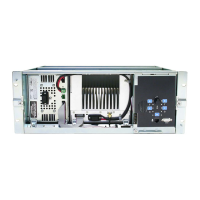76 Reciter Fault Finding TB8100 Service Manual
© Tait Electronics Limited September 2006
3.5 Initial Checks
These initial checks will verify whether:
■ the reciter powers up correctly
■ the reciter is correctly configured
■ any alarms have been generated
■ the 12.8MHz clock is running.
Task 1 —
Check DC Supply
1. Before starting any of these fault finding procedures, you must iden-
tify the model and hardware configuration of the reciter under test.
“Identifying the Reciter” on page 70 explains how to identify a
reciter from the product code printed on a label on the rear panel.
2. Set up the test equipment as shown in Figure 3.2 on page 73.
3. Power up the reciter using the standard test voltage of 28VDC.
4. Check that the current drawn is within the specified limits. The
current should be as listed in Table 3.1. If the current drawn is
correct, go to Tas k 2
. If it is incorrect, go to “Visual Inspection” on
page 82.
Note All measurements must be made at least 20 seconds after power-
up. This allows the DSP and RISC to power up and initialise the
reciter. Any measurements made during the first 20 seconds after
power-up will be incorrect.
Table 3.1 Typical operating current figures for the reciter
Reciter Configuration Typical Current
digital board only 90mA ±5mA
complete reciter
a
, Rx and Tx on
a. Digital board, RF board, and system interface board fitted and operational.
B and C bands
H band
K and L bands
285mA ±5mA
290mA ±5mA
286mA ±5mA

